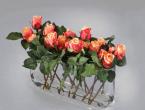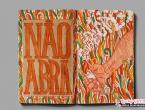DIY artificial flowers - make life brighter. Technology for making artificial flowers How to make an artificial plant
It’s not for nothing that the ancient Egyptians thought about how to make artificial flowers to decorate their bedrooms with. Living buds withered after a few hours, and the molded accessory remained fresh for a long time.
Later, the flower began to be made from woven fabric, porcelain, plaster, paper, soft metal, semi-precious stones, red and white clay, graded wood, and bird feathers. Nowadays it is called art, but in the Middle Ages it was called a commodity for sale. It cost so much that only a very rich person could buy it.
Making artificial flowers with your own hands is a rewarding task
Two centuries ago, capricious fashion turned its face to artificial flowers. The 19th century was its peak, when they began to decorate not only hair and clothes with buds, but also the interior. The demand turned out to be so great that even a special profession appeared - flower lacemaker. The specialty was given to young girls who completed the courses.
The year 1984 for St. Petersburg began with the publication not of a medical encyclopedia, but of a flower manual, where the experience of making buds from wax, leather and silk fabric was transferred. This year has become a pioneer for those who independently decided to take up a special type of needlework. The profits of sewing workshops went up: a rewarding leisure activity began to bring considerable profit. However, now this is also a profitable type of entrepreneurial activity.

How to make an artificial flower from organza and other materials
To begin, take a sheet of drawing paper and a soft pencil. Draw three simple flowers on a leaf, but of different sizes, one of which will be the smallest, the second medium, and the third large. Each opened bud has 5 petals. Use scissors to cut out each piece: these are your templates.
Transfer the templates to the fabric, outline the outline with soap, carefully cut out from organza or other thin synthetic fabric. Why synthetics? The fact is that it is enough to burn the edges of such petals with an open flame of a candle so that they stop crumbling.

If you hold the candle on the left side, the petals will curl inward, and on the right, outward. But it is better if the material with the thumb is on the side where the bend is needed, and the flame moves only in one direction.
As a result, all blanks quickly take the required shape. All that remains is to fasten the middles of the bowl with thread, fishing line or a staple using a stapler. A thread knot can be hidden under the material if you start not with the last, largest piece, but with a medium and small one, carefully piercing the center of the flower. For decoration, use small beads or glass beads.
The last step in the work is securing the thread. To be neat, use a thin needle to pierce only two layers of organza to secure the thread. Preferably by the stitches, but so that the knot does not come undone.

As a result, you have a beautiful open bud in front of you: all you have to do is attach a thick wire stem to it and you can put it in a vase.

How about for a large apartment? In the same way, but use thicker, brightly colored fabric for the buds rather than organza.
How to make artificial flowers. Video
It is difficult to find a person who does not love fresh flowers, their beauty and freshness, delicate aroma. Unfortunately, plants created by nature are not suitable for every situation: each of them lives according to its own rhythm and does not always bloom at the time we need. Compositions made from natural flowers quickly wither and lose their attractiveness; they are not suitable for permanent decoration. In stores it is not always possible to find bouquets made of fabric or polymer clay of the desired shape and color. The only way to get exactly what you want is to make artificial flowers with your own hands.
Imagine the envious glances of women and the admiration of men when you appear at a gala meeting in an elegant outfit, decorated with bouquets of delightful flowers. This decor will turn an ordinary hat into a flirty accessory; a single flower on a blouse will add piquancy to your entire look. Place bright flower arrangements in your apartment or office, or even just one flower, and the room will immediately come to life and become cozier.


When you admire a magnificent designer bouquet of artificial flowers, the thought may settle in your head: “I will never succeed.” Of course, it won’t work if you just look and doubt - get to work, and after a while your products will be difficult to distinguish from real flowers. It is not necessary to enroll in long, expensive courses; you can master this skill at home. It’s easy to learn how to create flowers from fabric; the master class will give you the necessary tips.

Basic materials used in flower making
To ensure that the work goes without annoying delays, prepare everything you need in advance. Let's start with choosing fabric. It is better for beginning craftsmen to use densely woven fabric; it holds its shape well. Please note that coarse, ugly fabrics will not make an elegant product; use shiny dense silk, satin or velvet. Try combining different types of fabrics, this way you will better reflect the diversity of the floral world. Perhaps you have some beautiful scraps left from some handicraft - do not neglect small scraps, it is very convenient to work with them.

The material has been selected, but before cutting can begin, it must be treated with a special compound.
Pour 3 teaspoons of gelatin with a glass of water, let it brew and heat until completely dissolved.
Soak the fabric in the solution and dry without wringing. After complete drying, the fabric is ready for cutting.
Fabric flowers step by step
Pattern of the future flower
Before you start cutting fabric, remember two basic rules. Firstly, any part should be located at an angle of 45 degrees to the grain thread; secondly, when transferring the outline to the material, you cannot use pencils and pens; a trace from them will ruin the entire appearance of the product. There are special crayons that are also great for drawing small pieces of soap on fabric.
Start by making a flower with 18 petals. Draw a pattern of a large, medium and small petal on paper and see if you have calculated their proportions correctly. The shape depends on your imagination, but at first it is better to avoid too fancy configurations. Start by copying the petals of a living flower; when you gain experience, you will be able to come up with the most intricate options.

Cut out 6 pieces of each size from the fabric and label them immediately. Be sure to indicate whether it is the large, small or middle part of the flower and mark the right and left sides. On the table everything seems clear, but after a while, if you don’t mark the cut, it will be difficult to understand the small shreds.
Making corrugated petals
Your fabric flower will look much more beautiful if the petals are made corrugated. The work will require the finest fabric, and at the same time it must be very durable, for example, chiffon or organza. Place the piece folded in half on additional material so that the fold line is 45 degrees with the grain of the thin fabric.

Press the entire surface of the petal firmly onto a flat surface and pull the additional fabric, turning it counterclockwise. The strength of the thin material plays an important role here; if it breaks, you will have to start all over again. Corrugated petals gain volume and look more natural.
Flower assembly
The finished petals need to be collected into a corolla. Sew the larger pieces to each other and close the circle. To give the petals a bulge, make small folds at the bottom of each of them. The next turn forms a medium-sized cut; the smallest details complete the work.
Final finishing
The main work is done, now you need to close the stitches holding the petals together. To do this, cut a circle out of fabric, fold it in four and secure the sharp corner in the center of the flower with an invisible seam. Glue another circle on the outside, it will cover all the threads, and the fabric flower will look like a living plant. They can be used to decorate, for example, a baby’s hat.

Additional materials for making flowers
The choice of glue and paints is a responsible matter: these materials can ruin the entire work.
Paints and dyes
The color of the petals should be clean and even; when using low-quality dyes, stains and unpainted areas appear; such a product is unlikely to decorate clothes or interiors. To give the fabric the desired color, you can use aniline and food dyes, photo paints, ink and ink.
By mixing the three primary colors in various proportions: red, yellow and blue, you can get any shade. The color intensity can be adjusted by diluting the dye. For dilution, water is used, or preferably alcohol or vodka, they give the color brightness and freshness. Mascara is used to make black parts, and if you dilute it, you get a gray dye.

Consider fresh flowers; they are very rarely colored the same throughout their entire volume. Combine shades and color intensity, and the product will take on a natural look.
High quality glue
To create high-quality artificial flowers with your own hands, you need good glue.
The main requirement: after drying, the glue should not leave marks or change the color of the petals.
In addition, it must have sufficient strength so that the product does not fall apart on the second day after production. Trade offers many different types of glue, but its properties may not always satisfy the buyer.
Glue at home
Prepare the glue yourself, then you will be sure of the quality of the material. To make flowers, only two types of glue are enough.
To cook flour paste, stir 2 tbsp. spoons of flour in water (the mixture should be as thick as liquid sour cream). The solution is heated, stirring, until the flour is brewed and the paste becomes translucent.
To prepare gelatin glue, soak 1 teaspoon of gelatin in a glass of cold water. When it swells, add a teaspoon of granulated sugar and 2 tbsp. spoons of flour, place on low heat and, stirring constantly, bring to a boil.
There are hardly anyone who doesn’t like fresh flowers. No matter how beautiful they are, they are destined to fade over time. The same cannot be said about skillfully made artificial flowers that will delight you for as long as you want, will not cause allergies and will become a noticeable decoration of the interior.
Fabric flowers
Satin, chintz, satin, velvet, silk, brocade and even leather are suitable for creating fabric floral arrangements. If you wish, you can combine different materials, but it is important not to overdo it in order to get a harmonious composition.
Materials you will need: fabric 100×10-15 cm, scissors, threads with needles and decor for decorating the flower core (beads, rhinestones, beads, pearls)
- Take a piece of fabric, fold one edge to hide the edge, fold the piece in half lengthwise, and secure the corner with thread.
- We sew a running stitch along the entire length of the fabric (forward needle stitch). Having reached the edge, we turn the fabric inward and wrap the end of the fabric in the same way as the first.
- We assemble the resulting ribbon: we pull the thread from one edge so that the fabric wrinkles and we get a flower.
- We twist the flower in a spiral, starting from one edge - this will make the inflorescence more magnificent. We shape the petals with our fingers to your taste: you can make them large, blooming, or you can leave a neat miniature bud.
- Having completed the molding of the flower, we secure it with thread so that the flower does not come apart and retains the chosen shape.
- To make the flower neat, the layers should be located approximately at the same level. Secure the flower with one simple seam, across the edge of the fabric. The resulting “rose” can serve as a decoration for a dress, hat, or be used as a boutonniere, brooch or hairpin.
Organza flowers
Organza is one of the favorite materials of decorators. It produces not only tulle and wedding accessories, but also flowers. To make organza flowers, you will need scissors, glitter glue, beads or seed beads.

- Cut out a flower with four petals from fabric. The petals can have any configuration, either with rounded or sharp edges. We will need two of these flowers.
- Carefully apply glue with glitter to the outline of the flower; similarly, using glue, we make 2-3 lines on the fabric petal - these are the stamens.
- After the glue has dried, glue one flower to another with glue or double-sided tape. You need to distribute the pieces of fabric in such a way that the petal of one flower stands between the two petals of another; as a result of these manipulations, you will get a flower with 8 petals.
- We decorate the center of the resulting flower with beads, beads or sparkles.
Leather flowers
Leather is a very pliable material, leather flowers look noble and, most importantly, expensive. Leather is easy to work with if you know some subtleties. For example, thick material makes straight petals better; thin leather is much easier to bend and, accordingly, make voluminous compositions.
Treat the inside of the flowers with PVA glue mixed with water in a ratio of 1:4. While the petals are drying, the edges of the future flower need to be stretched so that they take a more attractive shape. Next, collect the petals using a thread and a needle, and decorate the core with a bead. Glue a special lining to the underside of the flower - it will help fix the flower faster.

Flowers from foamiran
Foamiran is a fairly new material, it is a plastic suede or foam rubber. The material is used in creating flower arrangements, is used in scrapbooking, and is used to make toys.
Foamiran is a very plastic material, it stretches easily and remembers its new shape. The shape is fixed using a hot iron. The rich color palette allows you to use the material when creating a wide variety of handmade crafts. In addition, foamiran can be painted with ordinary crayons. Flowers made of plastic suede return to their original position after being crushed and retain their original appearance for a long time.

First make petal templates on cardboard, then cut out flowers from foamiran using them. It is better if you have multi-colored sheets of foamiran, for example, green, white, pink. Next, apply a hot iron to the petals for a few seconds, this will help them curl slightly and take on a natural shape. Using a toothpick you can draw veins; coloring the flower with crayons will help give it a natural look and additional volume. The petals are fastened together with hot glue. Keep in mind that the flowers of their foamiran look like they are alive, and therefore it is not recommended to use pebbles, rhinestones, or beads to decorate their cores.
How to make artificial flowers, so that it would be easy and simple, and you could also make money from it. Many who like to do everything with their own hands ask similar questions. The potential income that can be received is described in a separate section. The beauty of artificialflowers lies not so much in the income that you can get from this type of activity, but in the fact that you unwittingly preserve pristine nature without destroying natural beauty! Flowers that you make yourself will live forever, and they will be magnificent decorations or gifts . Read on to learn how to make fabric and ribbon flowers.
The video (How to make artificial flowers) is presented at the very bottom of the article for those who do not understand how to do it from the pictures.
3 ways to create artificial flowers
1 method of making a bud artificial flowers
1.Material for making artificial flowers
To make thin paper flowers that look like carnations, you just need a few simple supplies:
- 3 sheets of tissue paper
- Scissors
- Ruler and pencil
- Metal rod
- Adhesive tape (electrical tape)
- Floral ribbon


2.Cut out a rectangle from paper.
Use scissors to cut a rectangle measuring 30.48 cm long by 7.62 cm wide from the fabric.


3 .Draw lines on the rectangle. First, draw a line with a ruler and pencil 1.27 cm from the bottom of your paper rectangle. Draw a diagonal line from the top corner on side 1 that connects to the first line.


4.Cut along a diagonal line. The small remaining piece of napkin can be thrown away.


5.Create the fringe. Cut straight lines from the top of the diagonal. The cuts should follow a pencil line drawn straight through the napkin.


6.Glue the rod as shown in the picture using adhesive tape.


7.Fold the paper around a metal rod.


8.Attach the edge of the paper fabric around the stem (rod). Use clear tape for this.


9.Wrap floral tape around the top of the stem and the bottom of the flower.


10.Pull the paper clips away from the center. This will finish the clove.
Method 2 for making ribbon flowers
1.Get some tape and other supplies. You can use your imagination to make a ribbon with patterns and polka dots, or take a more realistic approach by choosing a ribbon in a shade reminiscent of petals. Here's what you need to make ribbon flowers:
- 30 cm tape
- Needle and thread that matches the length of the ribbon


2.Sew a white stitch along the length of the ribbon. This stitch weaves through the ribbon, allowing you to create a flower shape when you're finished.Guide the needle. Tie a knot at the end of the thread. This will hold it in place.Push the needle, front to back, into the ribbon along the edge. Pull the thread all the way through the knot. Push the needle from top to back and thread through. Repeat this to complete the stitch.


3. Pull the tape tightly. This should cause the tape to tighten before you finish the stitching. This step will create the basic shape of your ribbon flower: the petals.


4.Embroider the last few stitches - this will provide the shape of your ribbon flower.


5.Fold the ribbon so that it forms a circle. The tails of the ribbon should hang from your hand as you hold the flower.


6.Embroider the back part starting from the front along the edges of the ribbon. Stitch first, then down. Secure the thread with a knot (or 2 if necessary).


7.Cut off the ribbon tails. By cutting as close to the stitch line as possible, your flower will have a round shape.


8. Fasten the button in the center of the flower.
Method 3 for creating fabric for artificial flowers
1.Choose fabric and other accessories. Tulle, silk and other light, airy fabrics are ideal for making fabric flowers. Here's what you need:
A piece of fabric 10 cm wide and 60 cm long
Needle and thread
Needle
Iron

2.Fold the fabric in half.


3.Align the ends


4.Turn the piece of fabric inside out. The seams on both ends should now be on the inside.


5. Iron the ends. Do not iron the middle of the fabric or the flower will have an unsightly crease.


6. Go along the long edge of the fabric. Point the needle and knot at one end. Straightening out the long edge of the fabric where it folds. Continue stitching until you reach the other end.


7.Gather the fabric


8.Gather the fabric as shown in the picture.


9.Sew the gathered ends together. Use the end of the thread to sew the gathered ends together to keep the rose in shape.


Undoubtedly, absolutely any thing is sold in shops, markets, and shopping centers today. This is probably why the value of a gift made increases significantly.
If you still think that artificial paper flowers are not capable of decorating a celebration, you are deeply mistaken. Today, designers make true creations out of paper that are instantly indistinguishable from real flowers. By the way, our ancestors began making flowers from paper, as well as other improvised materials, in ancient times. For example, Egyptian women who lived in 3000 BC loved to decorate themselves with artificial flowers, and in the Middle Ages in many European countries, artificial paper flowers were in special demand.
Agree, any beautiful flower, no matter whether it is alive or artificial, gives joy and a great mood. This means it’s time to try yourself in the craft and create the most beautiful artificial flowers from the most affordable materials.
To make paper flowers we will need:

Colored paper, which can have a wide variety of textures (corrugated, pressed, crepe or the simplest)
Compass
Glue
Threads
Additional materials, for example, wire for stems, beads, beads, buttons, rhinestones, sequins - for decorating flowers.
Origami is a fairly well-known direction that allows you to create your own work of art without purchasing special tools. In order for your paper flowers to turn out beautiful, you should follow the steps of completing the work.
1. Draw a circle on colored paper. To do this, you can use a regular compass or any round object, tracing its outline. As practice shows, the most optimal size is 135 millimeters in diameter.
2. In order to get a three-dimensional flower from paper, you need to cut out several such circles, which in proportions will be one smaller than the other. To do this, for example, you can reduce the diameter of each subsequent circle by approximately five millimeters.
3. Cut out at least six of these circles, different in diameter - if you decide to cut out fewer circles, your flower will not gain the necessary splendor.
4. Find the center of the circles. It will be much easier to do this if you used a compass when drawing circles. If not, fold the circle in half twice and then unfold it.
5. Divide the circles into the desired number of petals. It will be better if there are at least 12 petals - then the flowers themselves will be really beautiful and voluminous. To make the edges of the flowers look natural, give each petal a rounded shape.
6. Make cuts between the petals towards the circle. Then bend the edges of the petals inward, and this procedure must be done with each circle you get.
7. Once all the circles are ready, fold them together, starting with the largest one.
8. Secure the circles to each other using glue or a needle and thread. You can use these flowers without stems as table decorations, or you can make stems out of wire.
You can decorate these flowers as you wish. Undoubtedly, it can be made with or without reason. The main thing is a little patience.




